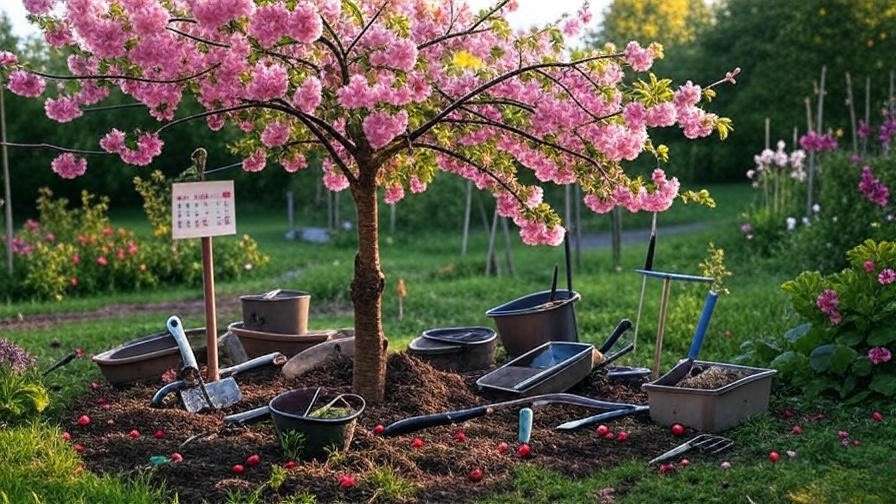Imagine stepping into your backyard, greeted by a cherry tree bursting with vibrant blossoms in spring and juicy, ripe cherries in summer. Now picture the disappointment of a sparse harvest or a tree plagued by pests. The difference? A well-executed cherry tree care plan for the whole year. Whether you’re a novice gardener or a seasoned arborist, a structured, year-round approach ensures your cherry tree thrives, producing bountiful fruit and stunning beauty. In this comprehensive guide, we’ll walk you through a month-by-month plan to nurture your cherry tree, drawing on decades of horticultural expertise and proven practices from university extension programs. Let’s grow a healthy, fruitful tree together! 🍒
Understanding Cherry Tree Basics 🍒
Types of Cherry Trees and Their Needs 🌿
Cherry trees come in two main types: sweet (e.g., Bing, Rainier) and sour (e.g., Montmorency). Sweet cherries thrive in mild climates (USDA zones 5–7), while sour cherries tolerate colder regions (zones 4–6). Choosing the right cultivar for your climate is critical. For example, ‘Stella’ is a self-pollinating sweet cherry ideal for smaller gardens, while ‘North Star’ sour cherries suit colder areas. Soil type matters too—cherries prefer well-drained, loamy soil with a pH of 6.0–6.5. A quick soil test (available at garden centers) can confirm your soil’s suitability.
| Cherry Type | Ideal Climate | Example Cultivars | Pollination Needs |
|---|---|---|---|
| Sweet | Zones 5–7 | Bing, Rainier | Often needs cross-pollination |
| Sour | Zones 4–6 | Montmorency, North Star | Usually self-pollinating |
Growth Stages of Cherry Trees 🌱
Cherry trees progress through distinct stages: dormancy (winter), budding and flowering (spring), fruiting (summer), and post-harvest recovery (fall). Each stage demands specific care. For instance, pruning during dormancy strengthens structure, while summer watering supports fruit development. Understanding these cycles helps you anticipate your tree’s needs, ensuring robust growth and productivity.
Tools and Supplies for Cherry Tree Care 🛠️
To care for your cherry tree effectively, gather these essentials:
- Pruning shears: For precise cuts on branches up to ½ inch thick.
- Loppers: For larger branches (up to 2 inches).
- Soil test kit: To monitor pH and nutrient levels.
- Organic mulch: Such as wood chips or bark to retain moisture.
- Fertilizers: Balanced (10-10-10) or nitrogen-heavy for young trees.
- Pest control: Organic options like neem oil or insecticidal soap.
- Sanitizer: Rubbing alcohol to clean tools and prevent disease spread.
Expert Tip: Always sanitize tools between cuts to avoid spreading pathogens like bacterial canker. Eco-friendly options, such as biodegradable mulch or organic fertilizers, are both sustainable and effective.
Month-by-Month Cherry Tree Care Plan 📅
Winter (December–February): Dormant Season Care ❄️
Pruning for Structure and Health ✂️
Winter is the ideal time to prune cherry trees, as they’re dormant and less susceptible to stress. Pruning shapes the tree, improves air circulation, and removes dead or damaged branches. For young trees (1–3 years), focus on establishing a strong central leader and open canopy. Mature trees need maintenance pruning to remove crossing branches or suckers.
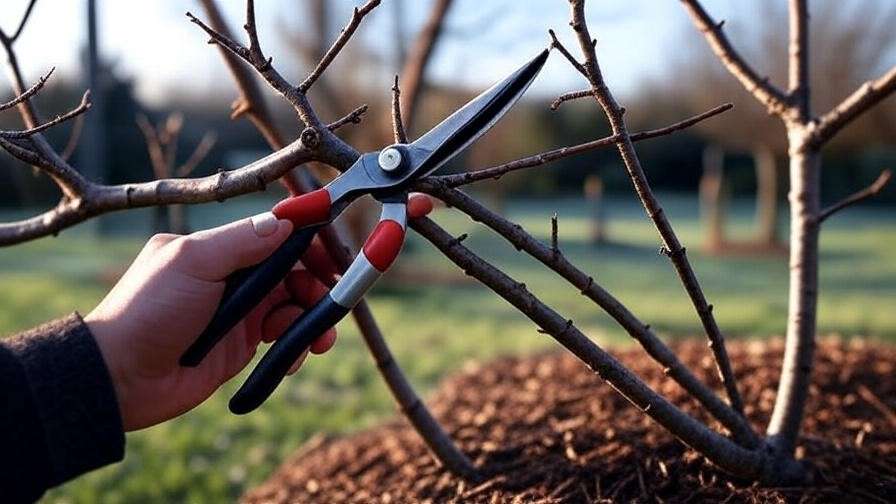
How to Prune:
- Sterilize tools with rubbing alcohol.
- Remove dead, diseased, or damaged branches.
- Cut back crossing branches to prevent rubbing.
- For young trees, select 3–4 strong scaffold branches, spaced evenly.
- Make clean cuts at a 45-degree angle just above a bud.
Example: A 2-year-old ‘Bing’ cherry tree might need its central leader shortened by one-third to encourage lateral growth, while a 10-year-old tree requires only light thinning to maintain shape.
Soil Protection and Preparation 🏞️
Winter is perfect for preparing soil for spring growth. Apply a 2–4 inch layer of organic mulch around the tree’s base (keeping it 6 inches from the trunk) to insulate roots and retain moisture. Test soil pH and nutrient levels using a kit from your local garden center. If pH is too low, add lime; if too high, incorporate sulfur. These amendments need time to integrate before spring.
FAQ: How often should you test soil for cherry trees? Test annually in winter to catch deficiencies early. For example, low nitrogen can stunt growth, while excess phosphorus can harm fruit quality.
Early Spring (March–April): Awakening Your Tree 🌸
Fertilizing for Growth 🌼
As buds swell, cherry trees need nutrients to fuel growth. Apply a balanced 10-10-10 fertilizer or a nitrogen-heavy formula (e.g., 16-20-0) for young, non-fruiting trees. Spread fertilizer evenly around the drip line (the area under the canopy’s edge), then water deeply. Avoid over-fertilizing, which can burn roots or promote excessive foliage over fruit.
Expert Insight: Organic fertilizers like composted manure or fish emulsion release nutrients slowly, reducing burn risk. Apply 1–2 pounds of fertilizer per year of tree age, up to 10 pounds for mature trees.

Pest and Disease Prevention 🐞
Early spring is prime time to prevent pests and diseases. Common threats include aphids, cherry leaf spot, and powdery mildew. Apply dormant oil sprays before buds open to smother overwintering pests. Ensure good air circulation by spacing trees 15–20 feet apart and pruning dense areas.
Case Study: A Michigan gardener noticed yellowing leaves on their ‘Montmorency’ tree. By applying a copper-based fungicide in early spring and improving drainage, they prevented cherry leaf spot, saving their harvest.
Late Spring (May): Flowering and Pollination 🐝
Supporting Pollination 🌺
Cherry trees rely on pollinators like bees for fruit production. Many sweet cherries (e.g., ‘Bing’) require a second tree for cross-pollination, while sour cherries are often self-pollinating. Plant pollinator-friendly companions like lavender or clover nearby to attract bees. Avoid pesticides during flowering to protect these vital insects.
Tip: Check your cultivar’s pollination needs. If space is limited, graft a compatible pollinator branch onto your tree or choose a self-pollinating variety like ‘Stella’.
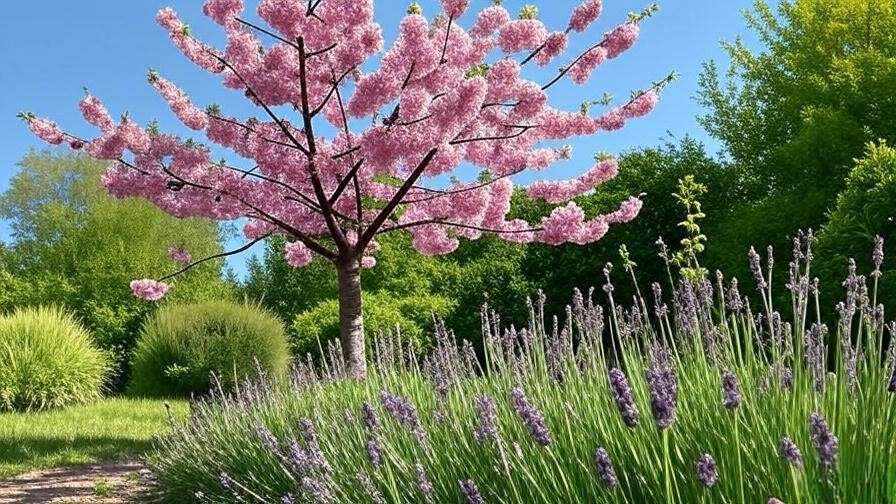
Monitoring Weather Risks ☔
Late frosts can damage delicate blossoms, reducing fruit yield. Monitor weather forecasts and cover trees with frost cloths or burlap during cold snaps. For dry regions, water weekly (1 inch) to support budding.
Summer (June–August): Fruit Development and Harvest 🍒
Watering and Nutrient Boosts 💧
Summer heat stresses cherry trees, especially during fruit development. Provide 1–2 inches of water weekly, using a soaker hose or drip irrigation for deep root penetration. Apply a light fertilizer dose (e.g., 5-10-10) in early June to support fruit growth.
Sample Watering Schedule:
- Young trees: 5–10 gallons weekly, depending on rainfall.
- Mature trees: 10–15 gallons weekly, applied slowly to avoid runoff.
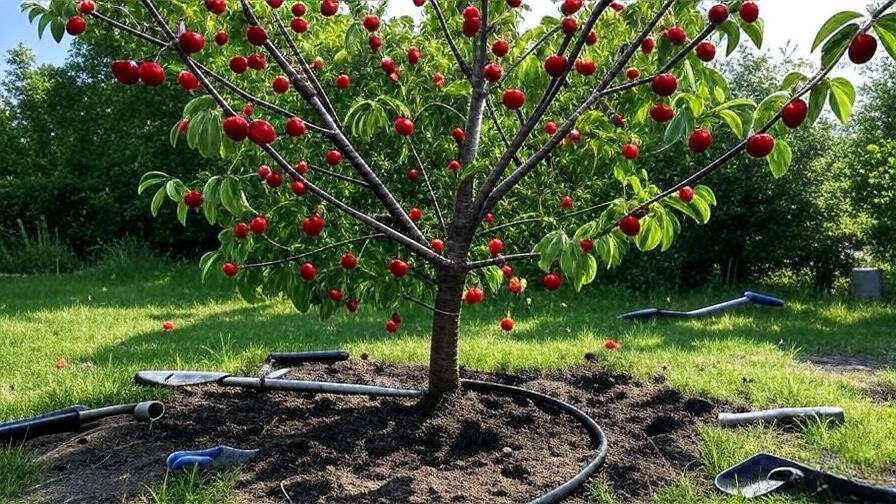
Pest and Disease Management 🕷️
Summer brings pests like cherry fruit flies and birds. Use sticky traps or kaolin clay sprays to deter flies organically. Netting protects fruit from birds without harming them. Monitor for brown rot (fuzzy gray patches on fruit) and remove affected cherries immediately.
FAQ: How to tell if your cherries are ripe? Sweet cherries turn deep red or black (depending on variety) and feel firm yet juicy. Sour cherries are bright red and slightly soft.
Harvesting Tips 🍇
Harvest cherries when fully ripe, as they don’t ripen off the tree. Gently twist fruit from stems to avoid tearing. Store in a cool, humid place (e.g., refrigerator) for up to 3 weeks. Freeze or can excess cherries for year-round enjoyment.
Fall (September–November): Preparing for Dormancy 🍂
Post-Harvest Care 🍁
After harvesting, your cherry tree needs care to recover and prepare for winter. Start by cleaning up fallen fruit, leaves, and debris around the base to prevent pests and diseases like brown rot or overwintering insects. Rake and dispose of debris in a compost pile away from the tree or seal it in bags for municipal pickup. This reduces the risk of fungal spores lingering in the soil.
Light pruning in early fall can also help. Remove suckers (shoots growing from the base) and water sprouts (vigorous upright shoots) to redirect energy to the main structure. Avoid heavy pruning, as it can stimulate new growth vulnerable to frost.
Example: A gardener in Oregon noticed fungal spots on their ‘Rainier’ cherry tree after a wet summer. By clearing debris and applying a fall fungicide, they prevented recurrence the next season.
Winterizing Your Tree 🥶
As temperatures drop, protect your cherry tree from cold and critters. Apply a fresh 2–4 inch layer of organic mulch (e.g., wood chips or straw) around the base, keeping it 6 inches from the trunk to avoid rot. For young trees (1–3 years), wrap the trunk with burlap or tree guards to shield against rodents and sunscald (bark cracking from temperature fluctuations).
Conduct a final soil test in early fall to assess nutrient levels. If deficient, apply slow-release amendments like compost or bone meal, which work over winter to enrich the soil. Water deeply before the ground freezes to ensure roots stay hydrated.
Expert Tip: In harsh climates (zones 4–5), use burlap wraps or breathable fabric to cover young trees entirely, protecting buds from freezing winds. Secure wraps loosely to allow air circulation.
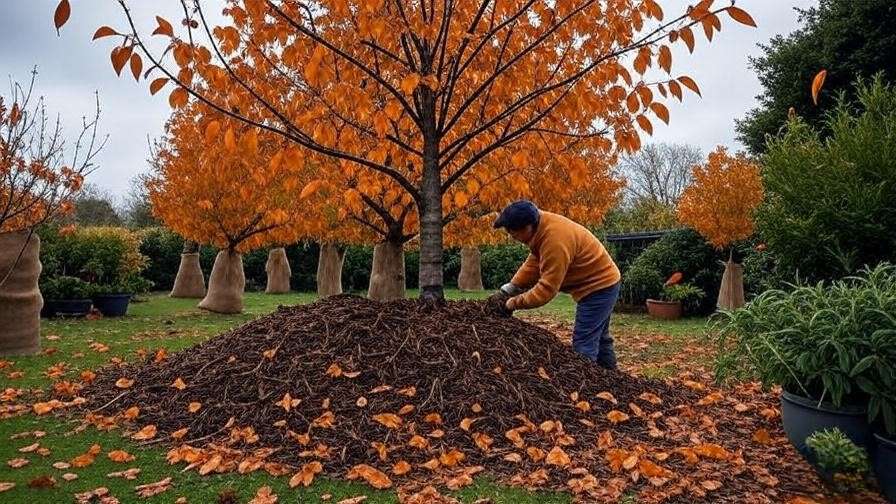
Common Cherry Tree Problems and Solutions 🩺
Diagnosing Issues Early 🔍
Early detection is key to saving a struggling cherry tree. Watch for these common issues:
| Problem | Symptoms | Solution |
|---|---|---|
| Nutrient Deficiency | Yellowing leaves, stunted growth | Test soil; apply balanced fertilizer or specific nutrients (e.g., nitrogen, potassium). |
| Overwatering | Wilting, soggy soil, root rot | Improve drainage; water less frequently. |
| Cherry Leaf Spot | Yellow leaves with black spots | Apply copper-based fungicide in spring; remove infected leaves. |
| Aphids | Curling leaves, sticky residue | Spray with insecticidal soap or neem oil. |
| Bird Damage | Pecked fruit, missing cherries | Use netting or reflective tape. |
Regularly inspect your tree for unusual signs, especially during active growth periods. A magnifying glass can help spot tiny pests like aphids or spider mites.

Organic and Chemical Treatments 🌿⚗️
Organic treatments are safer for pollinators and the environment but may require more frequent applications. Neem oil, insecticidal soap, and kaolin clay are effective against pests like aphids and cherry fruit flies. For diseases like brown rot, sulfur or copper-based fungicides work well when applied early.
Chemical treatments, such as synthetic pesticides, offer faster results but should be a last resort due to environmental impact. Always follow label instructions and avoid spraying during flowering to protect bees.
Step-by-Step Treatment Guide:
- Identify the issue using symptoms (e.g., sticky leaves = aphids).
- Choose an organic solution first (e.g., neem oil for pests).
- Apply early in the morning or late evening to minimize leaf burn.
- Monitor weekly and reapply as needed (follow product guidelines).
- Remove and destroy affected plant material to prevent spread.
Seasonal Maintenance Checklist ✅
To keep your cherry tree thriving, follow this concise checklist:
- Winter (Dec–Feb): Prune for structure, mulch roots, test soil pH, apply lime/sulfur if needed.
- Early Spring (Mar–Apr): Fertilize, apply dormant oil spray, monitor for pests.
- Late Spring (May): Support pollination, protect from frost, water weekly.
- Summer (Jun–Aug): Deep water, apply light fertilizer, monitor for pests/diseases, harvest ripe cherries.
- Fall (Sep–Nov): Clean debris, lightly prune, mulch, wrap trunks, conduct final soil test.
Downloadable Resource: Create a printable PDF version of this checklist on your website to help readers stay organized.
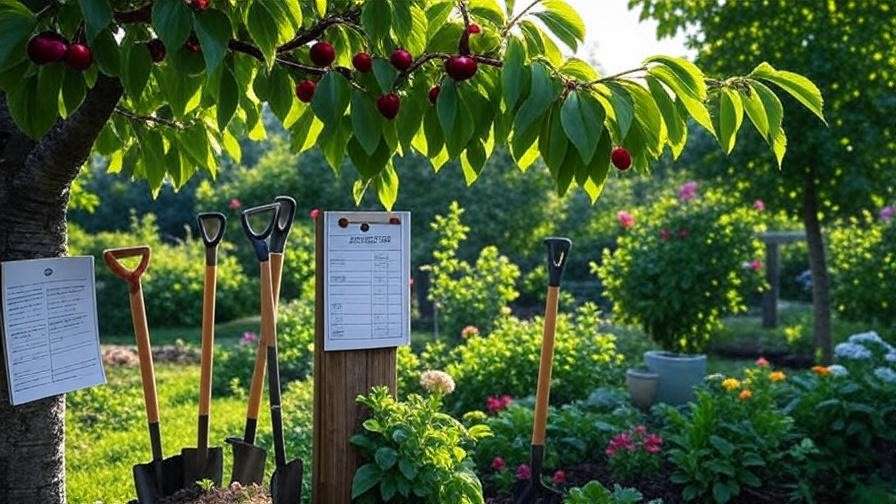
Expert Tips for Long-Term Cherry Tree Success 🌟
Horticulturists and arborists emphasize consistency for cherry tree longevity. Here are their top tips:
- Keep a Care Journal: Record pruning dates, fertilizer applications, and pest treatments to track what works.
- Rotate Pest Controls: Alternate organic treatments (e.g., neem oil, then insecticidal soap) to prevent pest resistance.
- Invest in Quality Tools: Sharp, durable pruning shears (e.g., Felco brand) make cleaner cuts, reducing disease risk.
- Monitor Weather Patterns: Use local weather apps to anticipate frost or drought and act proactively.
Case Study: A Washington state orchardist maintained a 20-year-old ‘Bing’ cherry tree by following a strict care schedule, including annual soil tests and organic pest control. Their tree consistently yields 50+ pounds of fruit annually, proving the value of diligent care.
FAQs About Cherry Tree Care ❓
Q: How often should I water my cherry tree?
A: Water young trees (1–3 years) with 5–10 gallons weekly, adjusting for rainfall. Mature trees need 10–15 gallons weekly during dry periods. Always water deeply to reach roots.
Q: Can cherry trees grow in containers?
A: Yes, dwarf varieties like ‘Lapins’ or ‘North Star’ thrive in large containers (15–20 gallons) with well-drained soil. Ensure consistent watering and winter protection.
Q: What’s the best time to plant a cherry tree?
A: Early spring or fall, when the tree is dormant, is ideal. Avoid planting in frozen or waterlogged soil.
Q: How do I protect my tree from birds?
A: Use bird netting or reflective tape. Install before fruit ripens to avoid damage. Motion-activated sprinklers can also deter birds safely.
These answers draw from university extension guidelines and practical gardening experience.
Conclusion: Your Path to a Thriving Cherry Tree 🌳
A year-round cherry tree care plan transforms your tree from a backyard feature to a productive, stunning centerpiece. By following this month-by-month guide—pruning in winter, fertilizing in spring, watering in summer, and winterizing in fall—you’ll ensure vibrant blossoms, healthy growth, and bountiful harvests. Start today by testing your soil or pruning your tree, and watch it thrive for years to come. Share your cherry tree journey with our community using #CherryTreeSuccess, and download our free care calendar at [yourwebsite.com/care-calendar] to stay on track!

